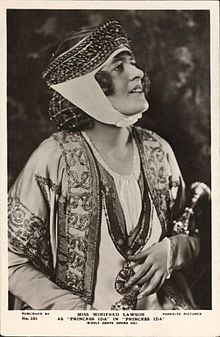Princess Ida
He also retained Tennyson's blank verse style and the basic story line about a heroic princess who runs a women's college and the prince who loves her.
[2] Therefore, in February 1883, with Iolanthe still playing strongly at the Savoy Theatre, Gilbert and Sullivan signed a new five-year partnership agreement to create new operas for Carte upon six months' notice.
[9] Sullivan finished some of the composition by early September when he had to begin preparations for his conducting duties at the triennial Leeds Festival, held in October.
[10] Gilbert was also producing his one-act drama, Comedy and Tragedy, and keeping an eye on a revival of his Pygmalion and Galatea at the Lyceum Theatre by Mary Anderson's company.
[11] In mid-December, Sullivan bade farewell to his sister-in-law Charlotte, the widow of his brother Fred, who departed with her young family to America, never to return.
The American star Lillian Russell was engaged to create the title role of Princess Ida, but Gilbert did not believe that she was dedicated enough, and when she missed a rehearsal, she was dismissed.
[13] The D'Oyly Carte Opera Company's usual female lead, Leonora Braham, a light lyric soprano, nevertheless moved up from the part of Lady Psyche to assume the title role.
[10] The previous Savoy opera, Iolanthe, closed after 398 performances on 1 January 1884, the same day that Sullivan composed the last of the musical numbers for Ida.
Sullivan, reflecting on this, his own precarious health and his desire to devote himself to more serious music, informed Richard D'Oyly Carte on 29 January 1884 that he had determined "not to write any more 'Savoy' pieces.
"[18] Sullivan fled the London winter to convalesce in Monte Carlo as seven provincial tours (one with a 17-year-old Henry Lytton in the chorus) and the U.S. production of Ida set out.
[19] As Princess Ida began to show signs of flagging early on, Carte sent notice, on 22 March 1884, to both Gilbert and Sullivan under the five-year contract, that a new opera would be required in six months' time.
Gilbert wrote to Sullivan asking him to reconsider, but the composer replied on 2 April that he had "come to the end of my tether" with the operas: ...I have been continually keeping down the music in order that not one [syllable] should be lost....
"[23] However, by 8 May 1884, Gilbert was ready to back down, writing, "...am I to understand that if I construct another plot in which no supernatural element occurs, you will undertake to set it?
[24] A particularly hot summer in London did not help ticket sales for Princess Ida and forced Carte to close the theatre during the heat of August.
[31] Although Gilbert's libretto contains many funny lines,[30] the iambic pentameter and three-act structure tend to make Ida more difficult to stage effectively than some of the other Savoy Operas.
Ida's war-like (and dull) brothers Arac, Guron and Scynthius, arrive at Hildebrand's palace ("We are warriors three"), preceding their father.
The three set off to Castle Adamant, while King Gama and his sons are to remain at Hildebrand's palace as hostages ("For a month to dwell in a dungeon cell").
One of the professors, Lady Blanche, doles out the punishments for the day, for "offences" that include bringing chessmen to the university – "men with whom you give each other mate" – and for sketching a double-perambulator.
Lady Blanche resents the princess's authority and predicts that one day she will replace her as head of the university ("Come mighty must", a song often cut from the D'Oyly Carte productions).
She falls in love with Florian at first sight, and the company celebrate joyously the discovery that men are not the monsters that Princess Ida had claimed ("The woman of the wisest wit").
Though indignant at first, she is persuaded to keep the men's secret when her daughter points out that if Hilarion is able to woo Princess Ida, Blanche will become head of the university ("Now, wouldn't you like to rule the roast?").
During lunch ("Merrily rings the luncheon bell"), Cyril gets tipsy and inadvertently gives away his friends' identity by singing a bawdy song ("Would you know the kind of maid").
Princess Ida reviews her student troops' readiness to meet Hildebrand's soldiers in battle, but the terrified girls admit that they are afraid of fighting ("Death to the invader!").
He suggests that, instead of subjecting her women to all-out war, she pit her three strong, brave brothers against Hilarion and his friends, with Ida's hand to depend on the outcome.
Hilarion makes an emotional appeal, urging her to give Man one chance, while Cyril observes that if she grows tired of the prince, she can return to Castle Adamant.
The other significant change is that, at some point in the 1920s, it became traditional to delete Lady Blanche's Act II song, "Come, mighty must" (although it continued to be printed in the vocal score).
[37] As had happened with their earlier operas in America, Carte, Gilbert and Sullivan could do nothing to stop producers from mounting unauthorised productions, since there was no international copyright treaty at the time.
The demands of the title role were considered unusual by Gilbert and Sullivan standards, and often the Company brought in guest artists to play it.
The film director Ken Russell staged Princess Ida for English National Opera in 1992, conducted by Jane Glover.
The radical contemporary concept involved an American-Japanese theme park version of Buckingham Palace, with a chorus of Madonna lookalikes (led by Rosemary Joshua as Ida) studying in the Tower of London; Gama (alternating Nickolas Grace and Richard Suart) operated a sushi chain.














